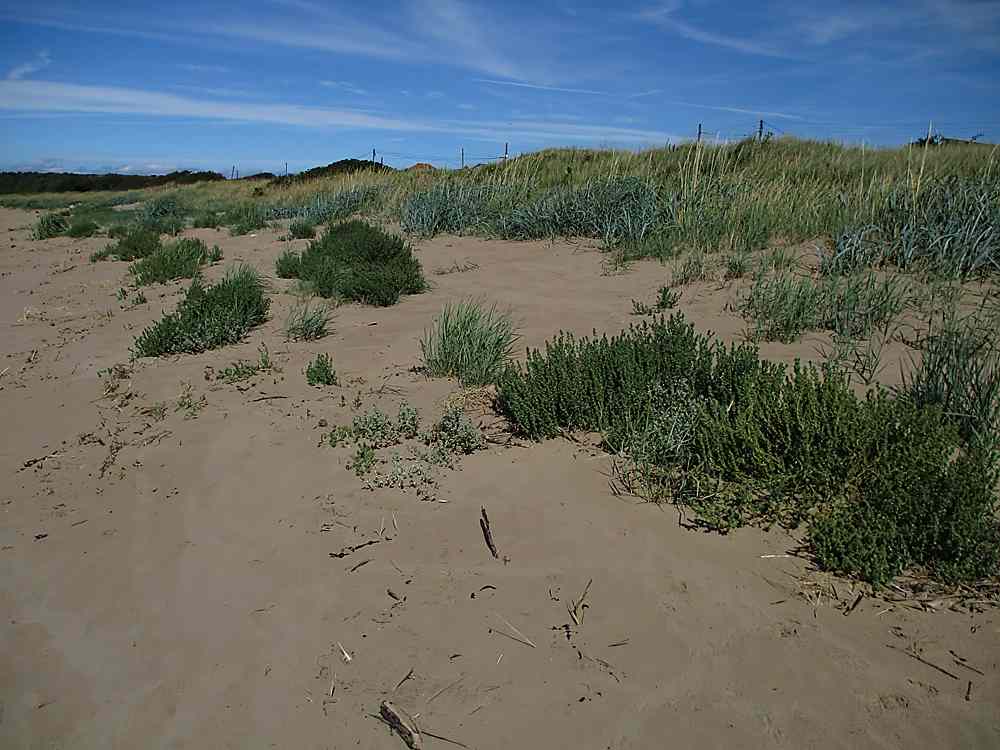Presidential address
Sand dunes represent one of the few natural habitats in Britain, although few have developed without intervention. There are sand dunes on the Somerset coast around Weston-super-Mare, Berrow and Brean: Rob focused his talk on Sand Bay, just north of Weston-super-Mare. Although the dunes here have developed only recently, all stages of dune succession are exhibited at Sand Bay.
Sand dunes begin to develop following the deposition of seaweed and flotsam at the top of the beach during high tides. This strandline material provides shelter and nutrients for pioneering species to germinate and grow. Successful pioneers must be adapted to withstand desiccation and high salinity: many are annual species of the Goosefoot family (Chenopodiaceae) which produce copious quantities of seeds. Prickly Saltwort, with fleshy spiny leaves, is one of the most important for incipient dune formation. As plants grow larger and pricklier, they trap wind-blown sand, creating embryonic dunes and providing shelter for the growth of other strandline species. At Sand Bay these include Frosted Orache, with grey mealy leaves to prevent desiccation, Sea-blite, which stores water in succulent leaves, Grass-leaved Orache and Babington’s Orache, Sea Beet, Sea Rocket, Sea Plantain and Sea Radish.
Inland of the embryonic dunes are the “yellow dunes”, dominated by perennial species such as Sea Spurge, but still with bare sand showing. Here the influence of extreme salinity is less, allowing the growth of Lyme-grass, Sand Couch, Sea Couch and Sand Sedge, all of which have far-reaching underground rhizomes which bind the sand and stabilise the dunes. A particularly beautiful plant found here is Sea Bindweed, with fleshy kidney-shaped leaves and stunning large pink flowers. As soil develops, the dunes become grey and consolidated and a more closed sward develops. The pretty pink Hare’s-foot Clover is common here, and also the fluffy alien grass, Hare’s-tail. Restharrow is a feature of consolidated dunes, being a creeping, strongly rooted plant. Its sticky leaves trap sand, contributing further to dune stabilisation. Other species of the more mature dunes include Curled Dock, Bur Chervil and Hound’s-tongue.
Storm events or human influences, particularly trampling, can create localised disturbance of dune grassland, allowing colonisation by smaller species, for example Buck’s-horn Plantain and the rare Curved Hard-grass.
Sadly, mature dunes of the Somerset coast are too often dominated by Sea Buckthorn, a spiny shrub, introduced for sea defence, which smothers all other vegetation. Other less damaging aliens add to the diversity of Sand Bay, including Seaside Daisy. In recent years, some more surprising plants have arrived, including Cabbage-palm and Spanish-dagger (Yucca gloriosa). Sand dunes are a mobile habitat, constantly changing, so there is always something new to find.
Rob left time for questions, some particularly thought-provoking. Given that most plants are now known to depend on mycorrhizae, are there particular strandline fungal species? And are there invertebrates which particularly eat the strandline plants? These could be subjects for another whole talk!
Helena Crouch

Fore Dunes © Rob Randall


Recent Comments